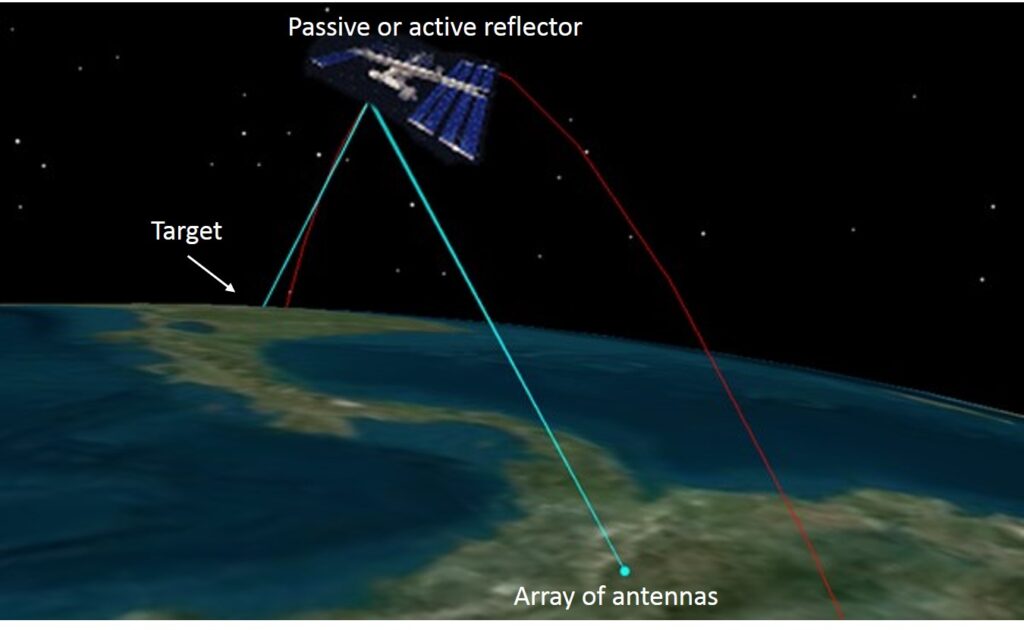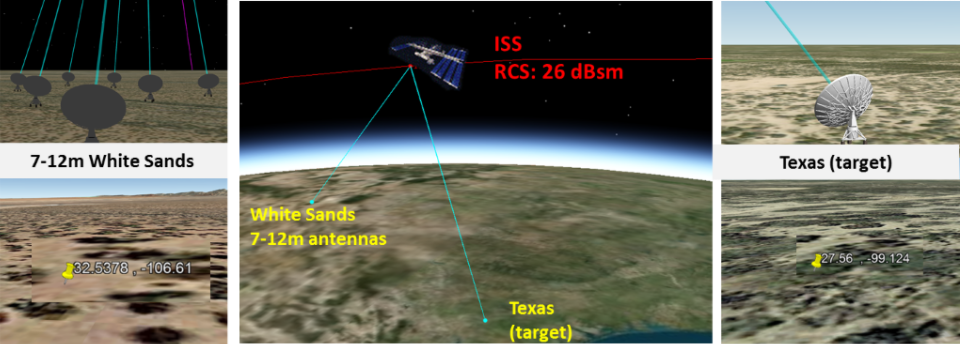Over-the-Horizon Arraying
Arrays for Beyond the Line-Of-Sight (BLOS) missions
Our notional OTH arraying technology can provide significant strategic advantages to communications, directed energy and electronic warfare missions.
DESCRIPTION
It may not always be possible to get an RF signal directly into an area. Perhaps
- Your target is in a hostile region
- There is no line-of-sight to your target
- You want to remain undetected to avoid attribution or jamming to your system
- Satellites have stopped working due to a massive solar storm or cyber-attack leaving OTH as the only option
In these cases, being able to bounce a signal off an air or Space object and have it arrive at a target could mean the difference between a tough day and a catastrophic day.

Over-the-Horizon (OTH) arraying is a way to get a signal to a ground target from an array of antennas when no direct line-of-sight exists between the two. It begins with an array of ground antennas coherently sending a signal to an available passive air or Space object. That reflected signal is then received at a target of interest.
Missions include: COMM, Electronic Warfare (EW) and Directed Energy (DE).
The transmitting ground system can be a made of quick deployable or large fixed stable antennas coherently arrayed. The choice depends on mission requirements and available resources.
The reflecting object that the signal is bounced off can be an active satellite such as the ISS, a dead or passive satellite such as Rigid Sphere, or an aircraft such as a drone.
Potential targets (recipients of the bounced signal) include
- A friendly COMM station requiring information (COMM)
- A hostile threat requiring mitigation (EW/Cyber)
- An object requiring power (DE)
The target is assumed to be over-the-horizon with respect to your ground system. This prevents a signal from being sent directly to it since there is no line-of-sight. Additionally, sending a signal from an air or Space system directly to the target may provide attribution or invite jamming. In such cases, our OTH arraying technology offers significant strategic advantages.
While a single, very large ground reflector antenna might be used in place of an array of smaller antennas, it is not often practical, beneficial, or safe to do so. A single large antenna
- Is limited in maximum EIRP while an array is not
- Is not easily deployed
- Doesn’t offer built-in redundancy (which is inherent in an array)
- May be an easy target for EW attacks since the energy can be traced back down to that specific antenna
In an array of smaller antennas, the power is distributed among the individual nodes and ray tracing techniques don’t lead to individual array antennas. These spatially dispersed antennas also enhance low probability of detection (LPD) and low probability of intercept (LPI).
We have demonstrated the capability of arraying widely-spaced, fixed, stable antennas so that the array signals arrive at the target in-phase at precisely the same time (coherently) in 2010. We have continued development on that method and also have a patented method for arraying quick deployable antennas. No wiring is used among the antennas; they work independently and autonomously.
INNOVATIONS
- Proven widely-spaced coherent transmit arraying technology
- Autonomous, continual self-calibration of the arrayed antennas providing instant 24/7 availability on power-up
- Over-the-Horizon Communication (OTH COMM)
- Over-the-Horizon jamming or cyber warfare (OTH EW)
- LPI/LPD array of widely-spaced quick deployable antennas for coherent RF transmissions
- Near-field and far-field array beam control to ensure maximum energy at a reflector
- Wide range of passive and active feedback objects possible
- Almost any satellite, active or passive, could be used as a reflector in an ITU radar band without interference
EXAMPLE

Consider a coherent array of widely-spaced 12m antennas at White Sands, NM bouncing a transmit signal off the ISS and back down to a ground target in Texas. If the range to the ISS is 784.8km at an elevation angle of 27.8 degrees and the receiver in Texas is 480km from the ISS at an elevation angle of 55.7 degrees, then if the target is a 1’ aperture, 12 Mbps can reach the target. This is equivalent to a USB 1.1/Full-Speed.
The system is expandable and of course the performance improves if the reflecting object is closer and/or larger.
BENEFITS
- Enables missions in areas too dangerous for troops
- Supports EW missions such as jamming and cyber warfare
- Provides RF communications in hard to reach locations
- Almost any satellite, active or passive, could be used as a reflector in a ITU radar band without interference
- Applicable to both small quick deployable and large fixed antennas
- Arraying algorithms for the quick deployable antennas have been proven
- Core technology for large fixed antennas has already been demonstrated (TRL-6, 2010)
- Avoids attribution due to arraying technology and signal bounce off
